RGU HSM139 MSc Public Health: Behaviour Change Intervention Report
VerifiedAdded on 2021/09/18
|9
|2242
|364
Report
AI Summary
This report provides a comprehensive analysis of a public health case study, focusing on behaviour change and intervention strategies. The assignment requires a critical examination of the chosen scenario using the biopsychosocial model of health, consideration of health psychology and theories of health behaviour change, and the identification and exploration of two possible interventions designed to influence health behaviours. The report also critically examines the contextual, environmental, and political factors impacting health behaviours and sustainability, supported by appropriate references and research evidence. The report aims to provide a deep understanding of the complexities of health behaviours and the development of effective public health interventions. The assignment adheres to a strict word limit of 3,000 words and follows the RGU Harvard referencing format.
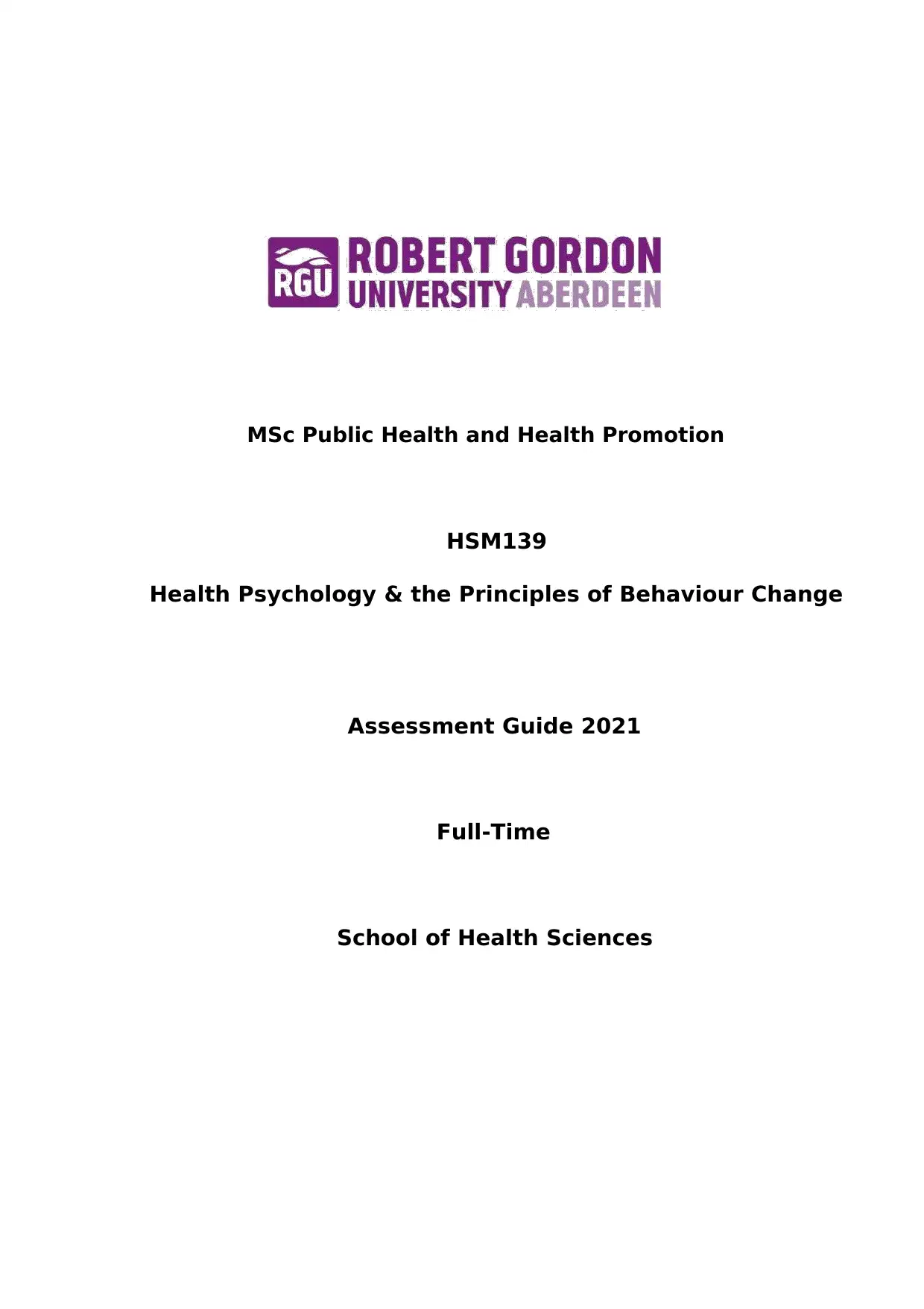
MSc Public Health and Health Promotion
HSM139
Health Psychology & the Principles of Behaviour Change
Assessment Guide 2021
Full-Time
School of Health Sciences
HSM139
Health Psychology & the Principles of Behaviour Change
Assessment Guide 2021
Full-Time
School of Health Sciences
Paraphrase This Document
Need a fresh take? Get an instant paraphrase of this document with our AI Paraphraser
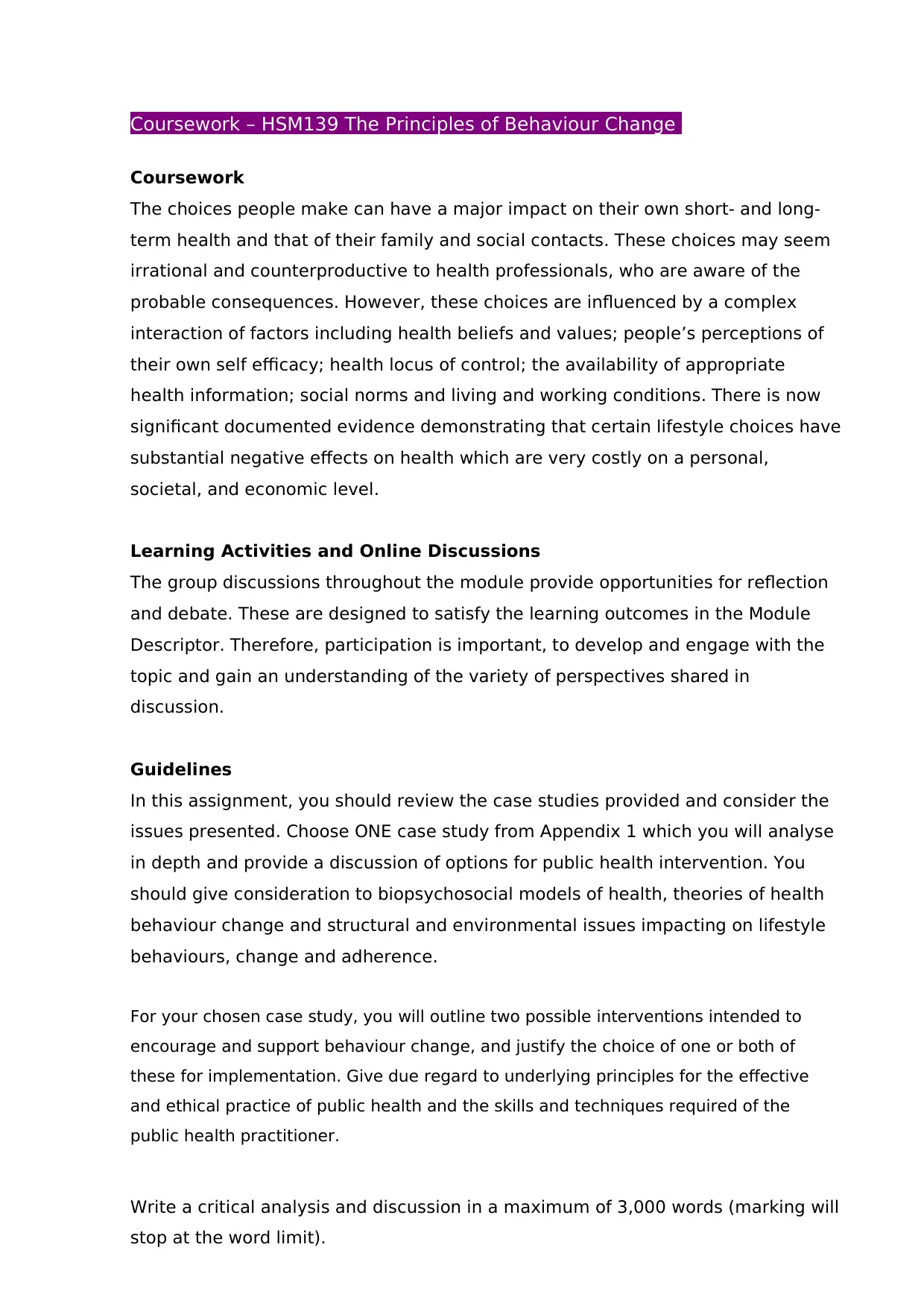
Coursework – HSM139 The Principles of Behaviour Change
Coursework
The choices people make can have a major impact on their own short- and long-
term health and that of their family and social contacts. These choices may seem
irrational and counterproductive to health professionals, who are aware of the
probable consequences. However, these choices are influenced by a complex
interaction of factors including health beliefs and values; people’s perceptions of
their own self efficacy; health locus of control; the availability of appropriate
health information; social norms and living and working conditions. There is now
significant documented evidence demonstrating that certain lifestyle choices have
substantial negative effects on health which are very costly on a personal,
societal, and economic level.
Learning Activities and Online Discussions
The group discussions throughout the module provide opportunities for reflection
and debate. These are designed to satisfy the learning outcomes in the Module
Descriptor. Therefore, participation is important, to develop and engage with the
topic and gain an understanding of the variety of perspectives shared in
discussion.
Guidelines
In this assignment, you should review the case studies provided and consider the
issues presented. Choose ONE case study from Appendix 1 which you will analyse
in depth and provide a discussion of options for public health intervention. You
should give consideration to biopsychosocial models of health, theories of health
behaviour change and structural and environmental issues impacting on lifestyle
behaviours, change and adherence.
For your chosen case study, you will outline two possible interventions intended to
encourage and support behaviour change, and justify the choice of one or both of
these for implementation. Give due regard to underlying principles for the effective
and ethical practice of public health and the skills and techniques required of the
public health practitioner.
Write a critical analysis and discussion in a maximum of 3,000 words (marking will
stop at the word limit).
Coursework
The choices people make can have a major impact on their own short- and long-
term health and that of their family and social contacts. These choices may seem
irrational and counterproductive to health professionals, who are aware of the
probable consequences. However, these choices are influenced by a complex
interaction of factors including health beliefs and values; people’s perceptions of
their own self efficacy; health locus of control; the availability of appropriate
health information; social norms and living and working conditions. There is now
significant documented evidence demonstrating that certain lifestyle choices have
substantial negative effects on health which are very costly on a personal,
societal, and economic level.
Learning Activities and Online Discussions
The group discussions throughout the module provide opportunities for reflection
and debate. These are designed to satisfy the learning outcomes in the Module
Descriptor. Therefore, participation is important, to develop and engage with the
topic and gain an understanding of the variety of perspectives shared in
discussion.
Guidelines
In this assignment, you should review the case studies provided and consider the
issues presented. Choose ONE case study from Appendix 1 which you will analyse
in depth and provide a discussion of options for public health intervention. You
should give consideration to biopsychosocial models of health, theories of health
behaviour change and structural and environmental issues impacting on lifestyle
behaviours, change and adherence.
For your chosen case study, you will outline two possible interventions intended to
encourage and support behaviour change, and justify the choice of one or both of
these for implementation. Give due regard to underlying principles for the effective
and ethical practice of public health and the skills and techniques required of the
public health practitioner.
Write a critical analysis and discussion in a maximum of 3,000 words (marking will
stop at the word limit).
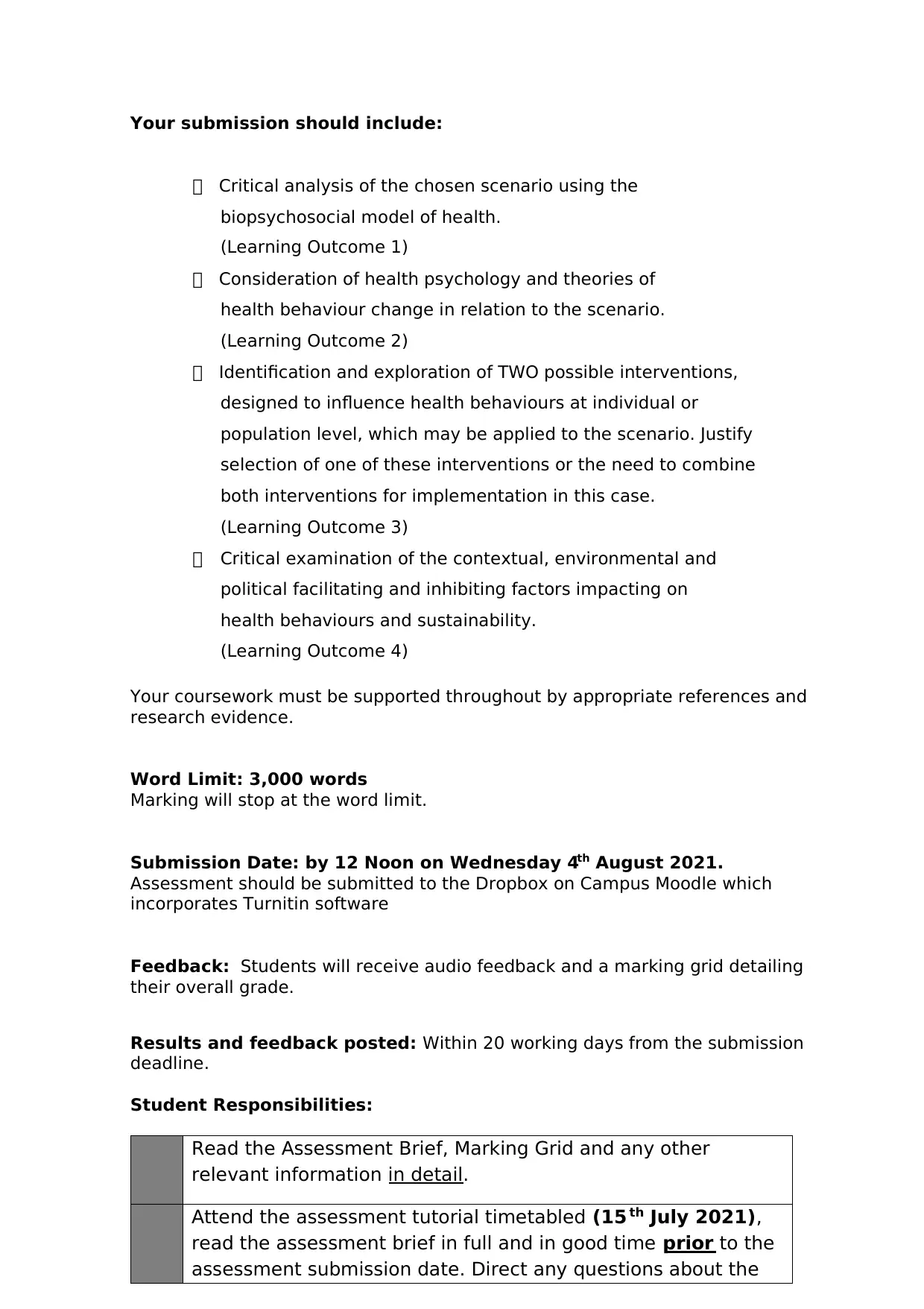
Your submission should include:
Critical analysis of the chosen scenario using the
biopsychosocial model of health.
(Learning Outcome 1)
Consideration of health psychology and theories of
health behaviour change in relation to the scenario.
(Learning Outcome 2)
Identification and exploration of TWO possible interventions,
designed to influence health behaviours at individual or
population level, which may be applied to the scenario. Justify
selection of one of these interventions or the need to combine
both interventions for implementation in this case.
(Learning Outcome 3)
Critical examination of the contextual, environmental and
political facilitating and inhibiting factors impacting on
health behaviours and sustainability.
(Learning Outcome 4)
Your coursework must be supported throughout by appropriate references and
research evidence.
Word Limit: 3,000 words
Marking will stop at the word limit.
Submission Date: by 12 Noon on Wednesday 4th August 2021.
Assessment should be submitted to the Dropbox on Campus Moodle which
incorporates Turnitin software
Feedback: Students will receive audio feedback and a marking grid detailing
their overall grade.
Results and feedback posted: Within 20 working days from the submission
deadline.
Student Responsibilities:
Read the Assessment Brief, Marking Grid and any other
relevant information in detail.
Attend the assessment tutorial timetabled (15 th July 2021),
read the assessment brief in full and in good time prior to the
assessment submission date. Direct any questions about the
Critical analysis of the chosen scenario using the
biopsychosocial model of health.
(Learning Outcome 1)
Consideration of health psychology and theories of
health behaviour change in relation to the scenario.
(Learning Outcome 2)
Identification and exploration of TWO possible interventions,
designed to influence health behaviours at individual or
population level, which may be applied to the scenario. Justify
selection of one of these interventions or the need to combine
both interventions for implementation in this case.
(Learning Outcome 3)
Critical examination of the contextual, environmental and
political facilitating and inhibiting factors impacting on
health behaviours and sustainability.
(Learning Outcome 4)
Your coursework must be supported throughout by appropriate references and
research evidence.
Word Limit: 3,000 words
Marking will stop at the word limit.
Submission Date: by 12 Noon on Wednesday 4th August 2021.
Assessment should be submitted to the Dropbox on Campus Moodle which
incorporates Turnitin software
Feedback: Students will receive audio feedback and a marking grid detailing
their overall grade.
Results and feedback posted: Within 20 working days from the submission
deadline.
Student Responsibilities:
Read the Assessment Brief, Marking Grid and any other
relevant information in detail.
Attend the assessment tutorial timetabled (15 th July 2021),
read the assessment brief in full and in good time prior to the
assessment submission date. Direct any questions about the
⊘ This is a preview!⊘
Do you want full access?
Subscribe today to unlock all pages.

Trusted by 1+ million students worldwide
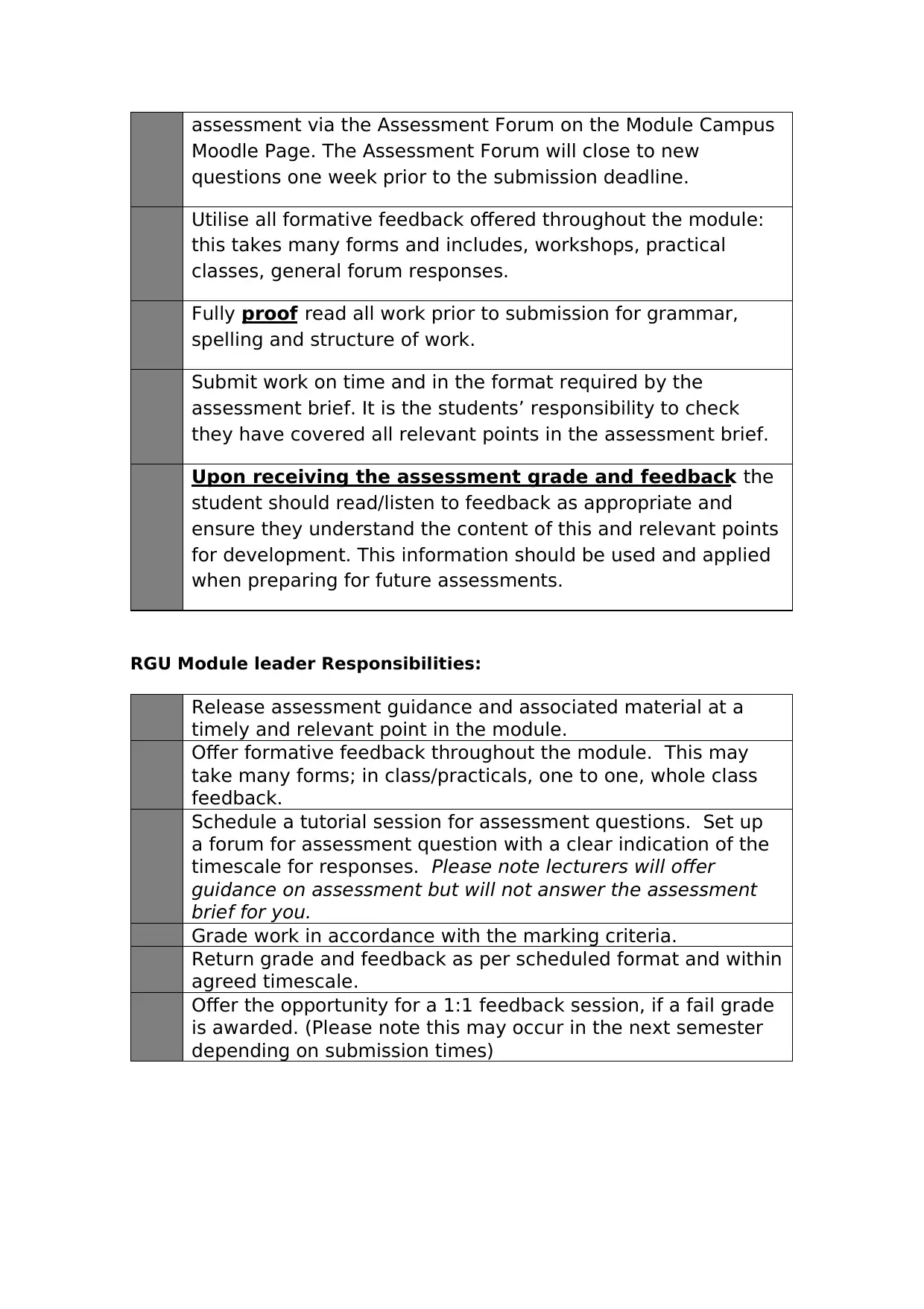
assessment via the Assessment Forum on the Module Campus
Moodle Page. The Assessment Forum will close to new
questions one week prior to the submission deadline.
Utilise all formative feedback offered throughout the module:
this takes many forms and includes, workshops, practical
classes, general forum responses.
Fully proof read all work prior to submission for grammar,
spelling and structure of work.
Submit work on time and in the format required by the
assessment brief. It is the students’ responsibility to check
they have covered all relevant points in the assessment brief.
Upon receiving the assessment grade and feedback the
student should read/listen to feedback as appropriate and
ensure they understand the content of this and relevant points
for development. This information should be used and applied
when preparing for future assessments.
RGU Module leader Responsibilities:
Release assessment guidance and associated material at a
timely and relevant point in the module.
Offer formative feedback throughout the module. This may
take many forms; in class/practicals, one to one, whole class
feedback.
Schedule a tutorial session for assessment questions. Set up
a forum for assessment question with a clear indication of the
timescale for responses. Please note lecturers will offer
guidance on assessment but will not answer the assessment
brief for you.
Grade work in accordance with the marking criteria.
Return grade and feedback as per scheduled format and within
agreed timescale.
Offer the opportunity for a 1:1 feedback session, if a fail grade
is awarded. (Please note this may occur in the next semester
depending on submission times)
Moodle Page. The Assessment Forum will close to new
questions one week prior to the submission deadline.
Utilise all formative feedback offered throughout the module:
this takes many forms and includes, workshops, practical
classes, general forum responses.
Fully proof read all work prior to submission for grammar,
spelling and structure of work.
Submit work on time and in the format required by the
assessment brief. It is the students’ responsibility to check
they have covered all relevant points in the assessment brief.
Upon receiving the assessment grade and feedback the
student should read/listen to feedback as appropriate and
ensure they understand the content of this and relevant points
for development. This information should be used and applied
when preparing for future assessments.
RGU Module leader Responsibilities:
Release assessment guidance and associated material at a
timely and relevant point in the module.
Offer formative feedback throughout the module. This may
take many forms; in class/practicals, one to one, whole class
feedback.
Schedule a tutorial session for assessment questions. Set up
a forum for assessment question with a clear indication of the
timescale for responses. Please note lecturers will offer
guidance on assessment but will not answer the assessment
brief for you.
Grade work in accordance with the marking criteria.
Return grade and feedback as per scheduled format and within
agreed timescale.
Offer the opportunity for a 1:1 feedback session, if a fail grade
is awarded. (Please note this may occur in the next semester
depending on submission times)
Paraphrase This Document
Need a fresh take? Get an instant paraphrase of this document with our AI Paraphraser
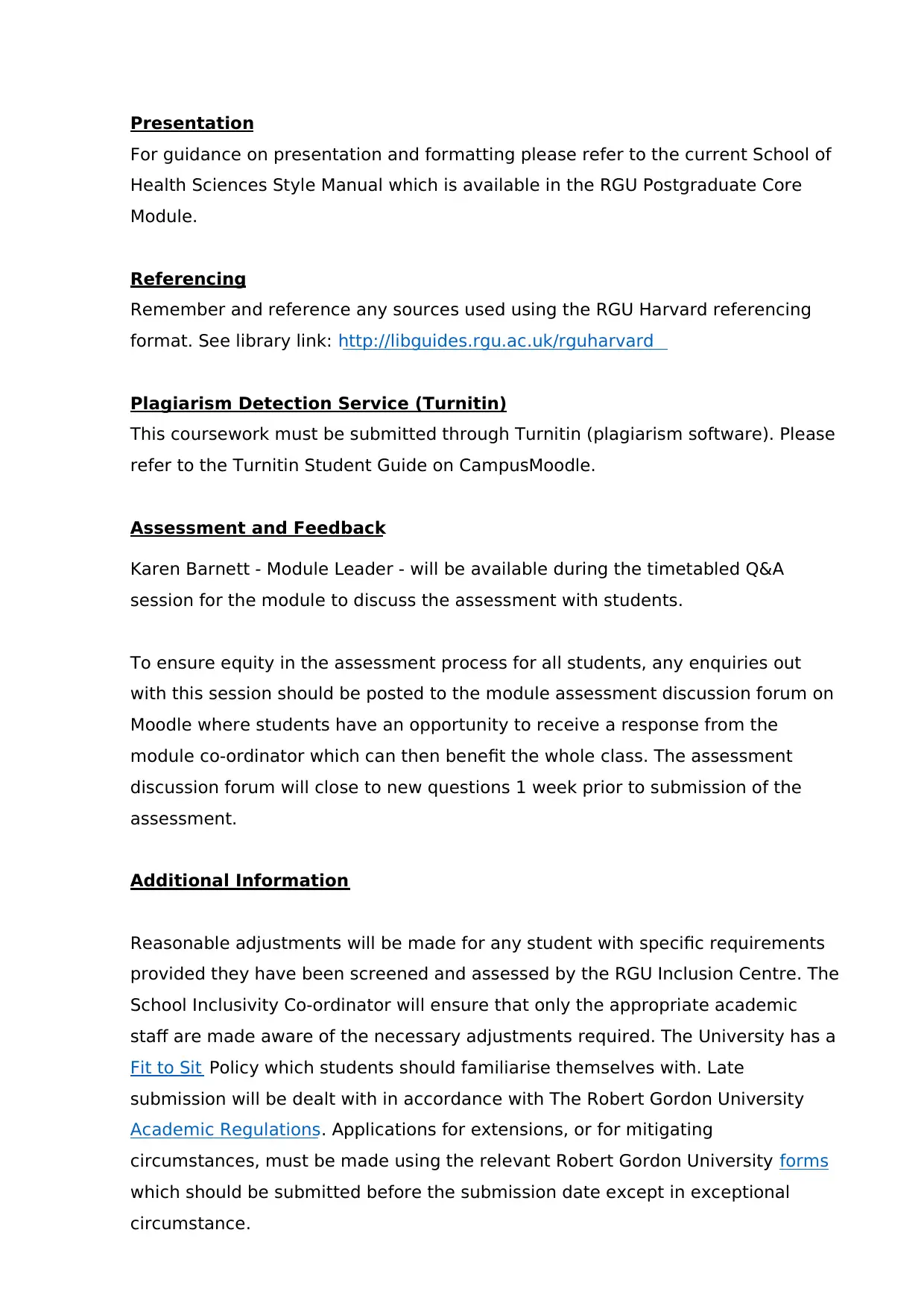
Presentation
For guidance on presentation and formatting please refer to the current School of
Health Sciences Style Manual which is available in the RGU Postgraduate Core
Module.
Referencing
Remember and reference any sources used using the RGU Harvard referencing
format. See library link: http://libguides.rgu.ac.uk/rguharvard
Plagiarism Detection Service (Turnitin)
This coursework must be submitted through Turnitin (plagiarism software). Please
refer to the Turnitin Student Guide on CampusMoodle.
Assessment and Feedback
Karen Barnett - Module Leader - will be available during the timetabled Q&A
session for the module to discuss the assessment with students.
To ensure equity in the assessment process for all students, any enquiries out
with this session should be posted to the module assessment discussion forum on
Moodle where students have an opportunity to receive a response from the
module co-ordinator which can then benefit the whole class. The assessment
discussion forum will close to new questions 1 week prior to submission of the
assessment.
Additional Information
Reasonable adjustments will be made for any student with specific requirements
provided they have been screened and assessed by the RGU Inclusion Centre. The
School Inclusivity Co-ordinator will ensure that only the appropriate academic
staff are made aware of the necessary adjustments required. The University has a
Fit to Sit Policy which students should familiarise themselves with. Late
submission will be dealt with in accordance with The Robert Gordon University
Academic Regulations. Applications for extensions, or for mitigating
circumstances, must be made using the relevant Robert Gordon University forms
which should be submitted before the submission date except in exceptional
circumstance.
For guidance on presentation and formatting please refer to the current School of
Health Sciences Style Manual which is available in the RGU Postgraduate Core
Module.
Referencing
Remember and reference any sources used using the RGU Harvard referencing
format. See library link: http://libguides.rgu.ac.uk/rguharvard
Plagiarism Detection Service (Turnitin)
This coursework must be submitted through Turnitin (plagiarism software). Please
refer to the Turnitin Student Guide on CampusMoodle.
Assessment and Feedback
Karen Barnett - Module Leader - will be available during the timetabled Q&A
session for the module to discuss the assessment with students.
To ensure equity in the assessment process for all students, any enquiries out
with this session should be posted to the module assessment discussion forum on
Moodle where students have an opportunity to receive a response from the
module co-ordinator which can then benefit the whole class. The assessment
discussion forum will close to new questions 1 week prior to submission of the
assessment.
Additional Information
Reasonable adjustments will be made for any student with specific requirements
provided they have been screened and assessed by the RGU Inclusion Centre. The
School Inclusivity Co-ordinator will ensure that only the appropriate academic
staff are made aware of the necessary adjustments required. The University has a
Fit to Sit Policy which students should familiarise themselves with. Late
submission will be dealt with in accordance with The Robert Gordon University
Academic Regulations. Applications for extensions, or for mitigating
circumstances, must be made using the relevant Robert Gordon University forms
which should be submitted before the submission date except in exceptional
circumstance.
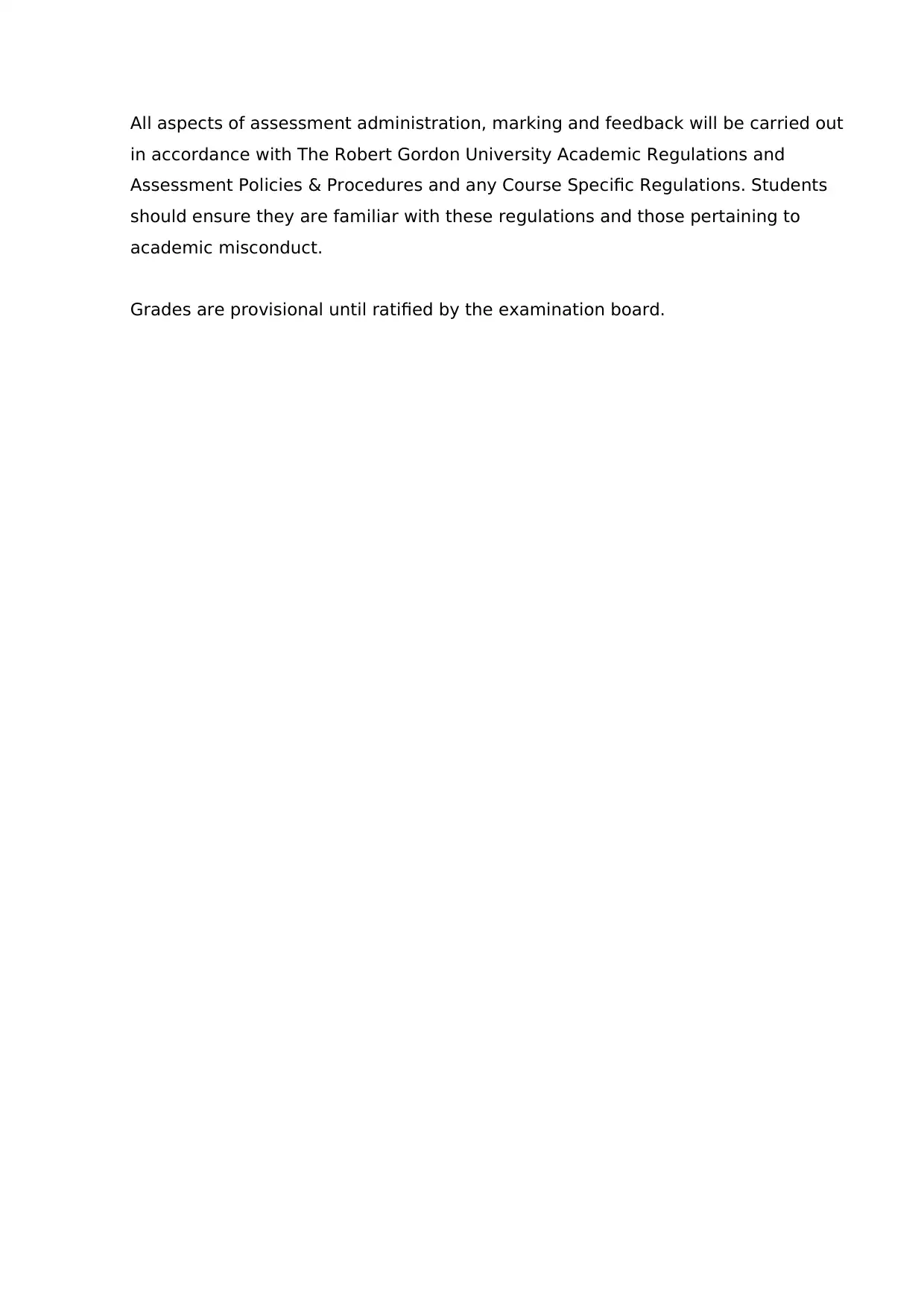
All aspects of assessment administration, marking and feedback will be carried out
in accordance with The Robert Gordon University Academic Regulations and
Assessment Policies & Procedures and any Course Specific Regulations. Students
should ensure they are familiar with these regulations and those pertaining to
academic misconduct.
Grades are provisional until ratified by the examination board.
in accordance with The Robert Gordon University Academic Regulations and
Assessment Policies & Procedures and any Course Specific Regulations. Students
should ensure they are familiar with these regulations and those pertaining to
academic misconduct.
Grades are provisional until ratified by the examination board.
⊘ This is a preview!⊘
Do you want full access?
Subscribe today to unlock all pages.

Trusted by 1+ million students worldwide
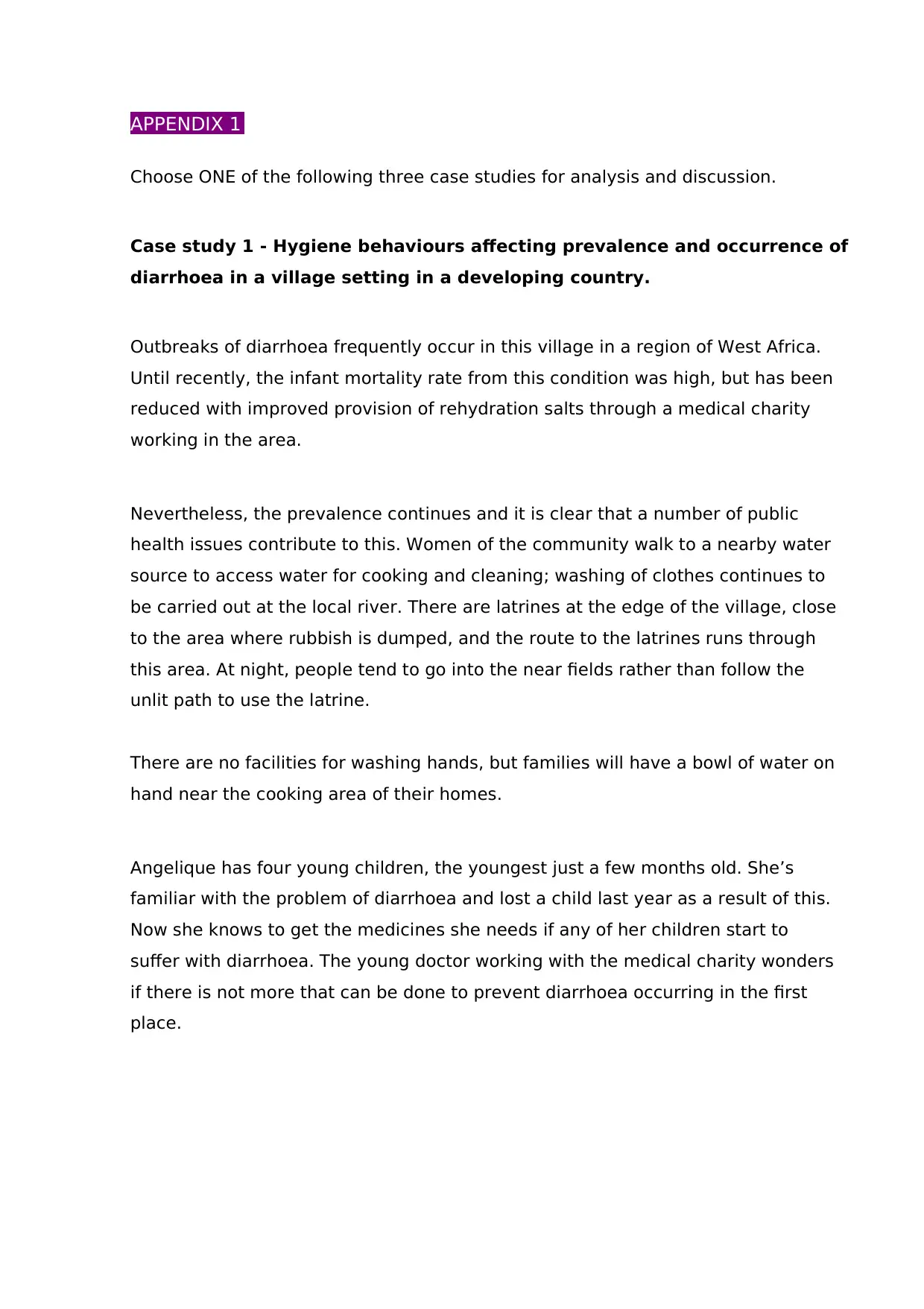
APPENDIX 1
Choose ONE of the following three case studies for analysis and discussion.
Case study 1 - Hygiene behaviours affecting prevalence and occurrence of
diarrhoea in a village setting in a developing country.
Outbreaks of diarrhoea frequently occur in this village in a region of West Africa.
Until recently, the infant mortality rate from this condition was high, but has been
reduced with improved provision of rehydration salts through a medical charity
working in the area.
Nevertheless, the prevalence continues and it is clear that a number of public
health issues contribute to this. Women of the community walk to a nearby water
source to access water for cooking and cleaning; washing of clothes continues to
be carried out at the local river. There are latrines at the edge of the village, close
to the area where rubbish is dumped, and the route to the latrines runs through
this area. At night, people tend to go into the near fields rather than follow the
unlit path to use the latrine.
There are no facilities for washing hands, but families will have a bowl of water on
hand near the cooking area of their homes.
Angelique has four young children, the youngest just a few months old. She’s
familiar with the problem of diarrhoea and lost a child last year as a result of this.
Now she knows to get the medicines she needs if any of her children start to
suffer with diarrhoea. The young doctor working with the medical charity wonders
if there is not more that can be done to prevent diarrhoea occurring in the first
place.
Choose ONE of the following three case studies for analysis and discussion.
Case study 1 - Hygiene behaviours affecting prevalence and occurrence of
diarrhoea in a village setting in a developing country.
Outbreaks of diarrhoea frequently occur in this village in a region of West Africa.
Until recently, the infant mortality rate from this condition was high, but has been
reduced with improved provision of rehydration salts through a medical charity
working in the area.
Nevertheless, the prevalence continues and it is clear that a number of public
health issues contribute to this. Women of the community walk to a nearby water
source to access water for cooking and cleaning; washing of clothes continues to
be carried out at the local river. There are latrines at the edge of the village, close
to the area where rubbish is dumped, and the route to the latrines runs through
this area. At night, people tend to go into the near fields rather than follow the
unlit path to use the latrine.
There are no facilities for washing hands, but families will have a bowl of water on
hand near the cooking area of their homes.
Angelique has four young children, the youngest just a few months old. She’s
familiar with the problem of diarrhoea and lost a child last year as a result of this.
Now she knows to get the medicines she needs if any of her children start to
suffer with diarrhoea. The young doctor working with the medical charity wonders
if there is not more that can be done to prevent diarrhoea occurring in the first
place.
Paraphrase This Document
Need a fresh take? Get an instant paraphrase of this document with our AI Paraphraser
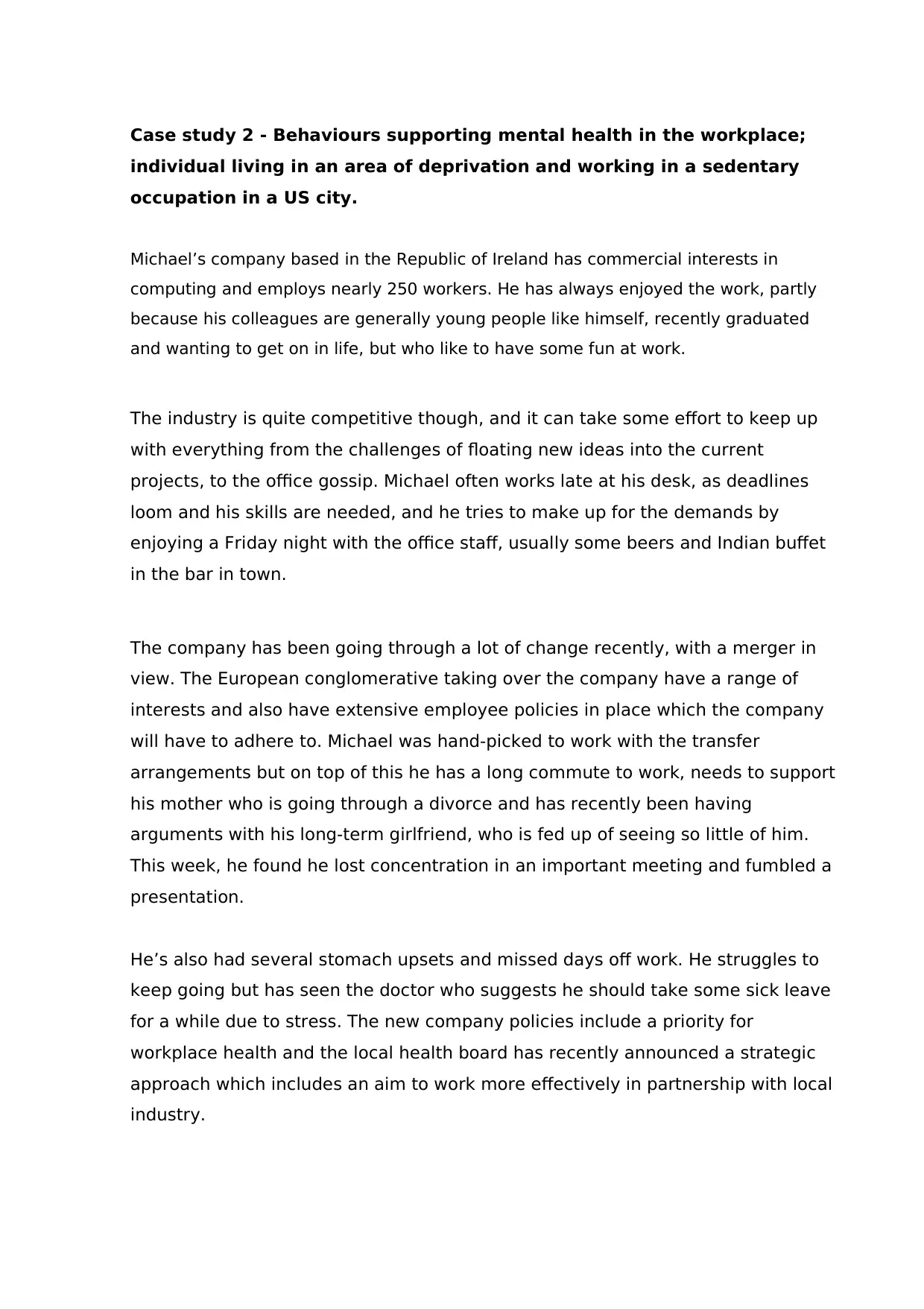
Case study 2 - Behaviours supporting mental health in the workplace;
individual living in an area of deprivation and working in a sedentary
occupation in a US city.
Michael’s company based in the Republic of Ireland has commercial interests in
computing and employs nearly 250 workers. He has always enjoyed the work, partly
because his colleagues are generally young people like himself, recently graduated
and wanting to get on in life, but who like to have some fun at work.
The industry is quite competitive though, and it can take some effort to keep up
with everything from the challenges of floating new ideas into the current
projects, to the office gossip. Michael often works late at his desk, as deadlines
loom and his skills are needed, and he tries to make up for the demands by
enjoying a Friday night with the office staff, usually some beers and Indian buffet
in the bar in town.
The company has been going through a lot of change recently, with a merger in
view. The European conglomerative taking over the company have a range of
interests and also have extensive employee policies in place which the company
will have to adhere to. Michael was hand-picked to work with the transfer
arrangements but on top of this he has a long commute to work, needs to support
his mother who is going through a divorce and has recently been having
arguments with his long-term girlfriend, who is fed up of seeing so little of him.
This week, he found he lost concentration in an important meeting and fumbled a
presentation.
He’s also had several stomach upsets and missed days off work. He struggles to
keep going but has seen the doctor who suggests he should take some sick leave
for a while due to stress. The new company policies include a priority for
workplace health and the local health board has recently announced a strategic
approach which includes an aim to work more effectively in partnership with local
industry.
individual living in an area of deprivation and working in a sedentary
occupation in a US city.
Michael’s company based in the Republic of Ireland has commercial interests in
computing and employs nearly 250 workers. He has always enjoyed the work, partly
because his colleagues are generally young people like himself, recently graduated
and wanting to get on in life, but who like to have some fun at work.
The industry is quite competitive though, and it can take some effort to keep up
with everything from the challenges of floating new ideas into the current
projects, to the office gossip. Michael often works late at his desk, as deadlines
loom and his skills are needed, and he tries to make up for the demands by
enjoying a Friday night with the office staff, usually some beers and Indian buffet
in the bar in town.
The company has been going through a lot of change recently, with a merger in
view. The European conglomerative taking over the company have a range of
interests and also have extensive employee policies in place which the company
will have to adhere to. Michael was hand-picked to work with the transfer
arrangements but on top of this he has a long commute to work, needs to support
his mother who is going through a divorce and has recently been having
arguments with his long-term girlfriend, who is fed up of seeing so little of him.
This week, he found he lost concentration in an important meeting and fumbled a
presentation.
He’s also had several stomach upsets and missed days off work. He struggles to
keep going but has seen the doctor who suggests he should take some sick leave
for a while due to stress. The new company policies include a priority for
workplace health and the local health board has recently announced a strategic
approach which includes an aim to work more effectively in partnership with local
industry.
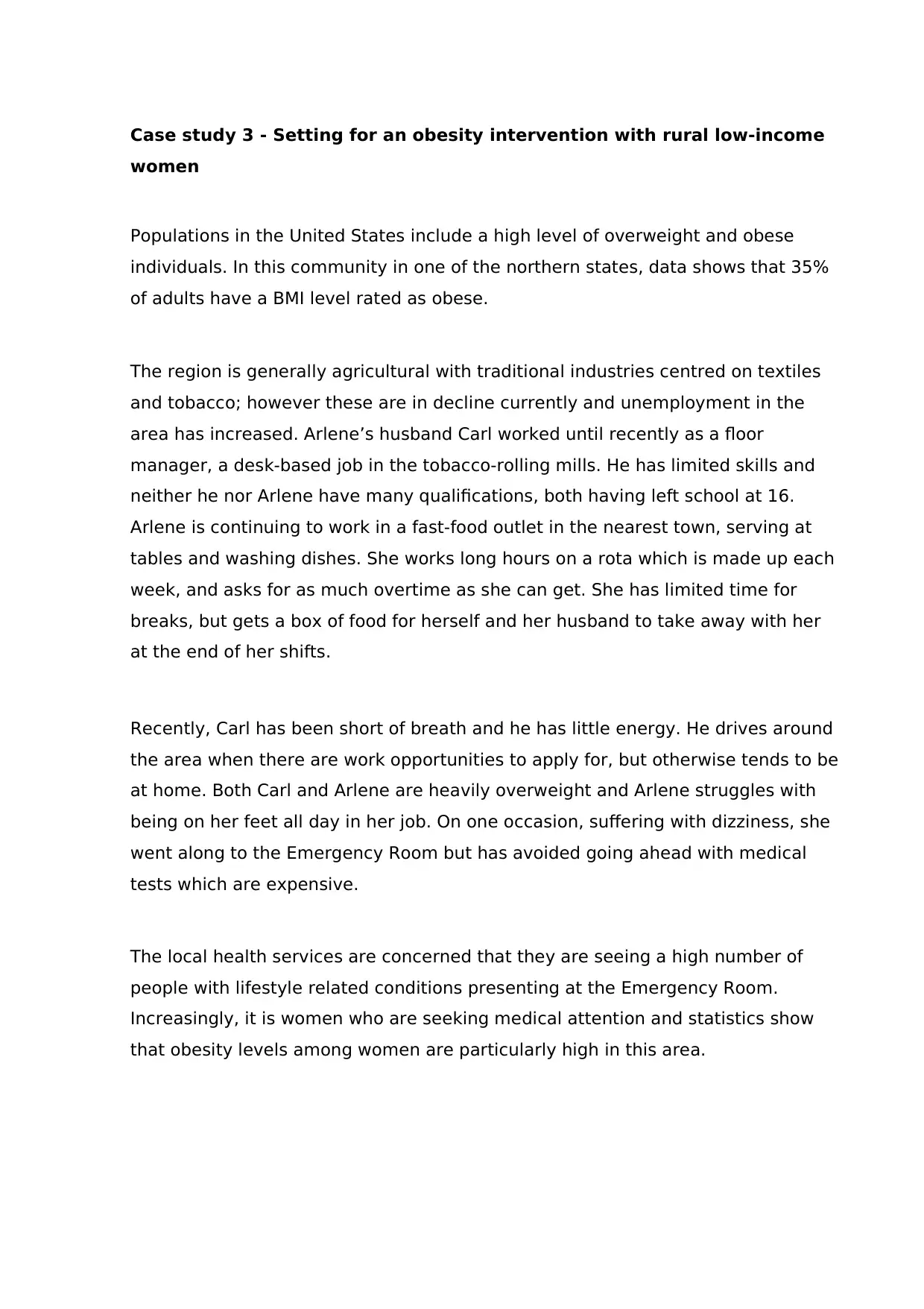
Case study 3 - Setting for an obesity intervention with rural low-income
women
Populations in the United States include a high level of overweight and obese
individuals. In this community in one of the northern states, data shows that 35%
of adults have a BMI level rated as obese.
The region is generally agricultural with traditional industries centred on textiles
and tobacco; however these are in decline currently and unemployment in the
area has increased. Arlene’s husband Carl worked until recently as a floor
manager, a desk-based job in the tobacco-rolling mills. He has limited skills and
neither he nor Arlene have many qualifications, both having left school at 16.
Arlene is continuing to work in a fast-food outlet in the nearest town, serving at
tables and washing dishes. She works long hours on a rota which is made up each
week, and asks for as much overtime as she can get. She has limited time for
breaks, but gets a box of food for herself and her husband to take away with her
at the end of her shifts.
Recently, Carl has been short of breath and he has little energy. He drives around
the area when there are work opportunities to apply for, but otherwise tends to be
at home. Both Carl and Arlene are heavily overweight and Arlene struggles with
being on her feet all day in her job. On one occasion, suffering with dizziness, she
went along to the Emergency Room but has avoided going ahead with medical
tests which are expensive.
The local health services are concerned that they are seeing a high number of
people with lifestyle related conditions presenting at the Emergency Room.
Increasingly, it is women who are seeking medical attention and statistics show
that obesity levels among women are particularly high in this area.
women
Populations in the United States include a high level of overweight and obese
individuals. In this community in one of the northern states, data shows that 35%
of adults have a BMI level rated as obese.
The region is generally agricultural with traditional industries centred on textiles
and tobacco; however these are in decline currently and unemployment in the
area has increased. Arlene’s husband Carl worked until recently as a floor
manager, a desk-based job in the tobacco-rolling mills. He has limited skills and
neither he nor Arlene have many qualifications, both having left school at 16.
Arlene is continuing to work in a fast-food outlet in the nearest town, serving at
tables and washing dishes. She works long hours on a rota which is made up each
week, and asks for as much overtime as she can get. She has limited time for
breaks, but gets a box of food for herself and her husband to take away with her
at the end of her shifts.
Recently, Carl has been short of breath and he has little energy. He drives around
the area when there are work opportunities to apply for, but otherwise tends to be
at home. Both Carl and Arlene are heavily overweight and Arlene struggles with
being on her feet all day in her job. On one occasion, suffering with dizziness, she
went along to the Emergency Room but has avoided going ahead with medical
tests which are expensive.
The local health services are concerned that they are seeing a high number of
people with lifestyle related conditions presenting at the Emergency Room.
Increasingly, it is women who are seeking medical attention and statistics show
that obesity levels among women are particularly high in this area.
⊘ This is a preview!⊘
Do you want full access?
Subscribe today to unlock all pages.

Trusted by 1+ million students worldwide
1 out of 9
Related Documents
Your All-in-One AI-Powered Toolkit for Academic Success.
+13062052269
info@desklib.com
Available 24*7 on WhatsApp / Email
![[object Object]](/_next/static/media/star-bottom.7253800d.svg)
Unlock your academic potential
Copyright © 2020–2025 A2Z Services. All Rights Reserved. Developed and managed by ZUCOL.





